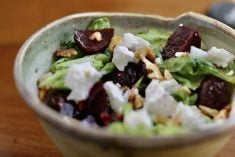We were watching a television show recently called Property Virgins that chronicles the experience of those shopping for their first home.
It highlighted the information needed and the many decisions that must be made when making that first huge investment.
It seemed to us that watching several episodes of this show should be a requirement for all first-time home buyers. There is so much that needs to be considered and so many extra fees and costs that most people don’t realize. It could be a good educational tool.
Read Also

Communication key to bridging generation gap
Each generation is shaped by the predominant forces at play during their formative years. Acknowledging these influences can improve communication among the generations.
Investing is only one area of financial knowledge.
Canadian consumers are faced with an ever-increasing complexity of products, services, equipment and options in the modern banking age, whether it be personal banking, credit or financial decisions.
They must have a good level of knowledge and know their rights when accessing the most basic financial products and services, such as chequing and savings accounts, credit cards, debit cards and on-line banking.
This financial knowledge area is becoming known as financial literacy.
The need for a financially literate society has been highlighted in the last several years by the increase in personal debt, including credit card debit, which has led to increases in personal bankruptcies.
Large losses from fraudulent investment schemes and the global financial crisis show the need for all members of society to be better educated in money and financial management skills.
The Financial Consumer Agency of Canada (FCAC) is responsible for monitoring federally regulated financial institutions to ensure they comply with the law. It also educates consumers to ensure they have the information and skills they need to actively transact with the financial services sector. This includes developing financial literacy education instructional materials.
In partnership with the British Columbia Securities Commission, FCAC launched an educational web resource to help high school students learn about financial issues.
The City: A Financial Life Skills Resource draws students into daily scenarios where they practice financial decision-making activities such as budgeting, saving, credit and debt, insurance, taxes and investing.
At the end of the course, they prepare a financial plan for after graduation. The resource is hands-on and activity-based. Students learn basic financial life skills by making financial decisions for fictional characters.
Each financial topic is introduced with mini soap opera stories involving the characters, including exposure to financial frauds and scams and lessons on how to safeguard themselves.
The material is designed to be easy for the teacher to use. The website includes downloadable lesson plans, overheads, student handouts, worksheets and online modules.
The statistical information is customized to each province and uses the most recent statistic and census information.
Teachers can adapt the resource to in-class lessons or self-guided on-line modules that students can complete at their own pace.
Courses include career planning, life transitions, consumer studies, business education and mathematics.
The City is available for free in English and French on the Money Belt at themoneybelt.gc.ca, a new financial education website for teachers and youth.
A self-directed training guide and online services are available to teachers. A similar resource is being developed for adults.
This is a great first step for improving the financial literacy of young people and for preparing them for that major purchase of their first home.
My daughter-in-law mentioned a Moroccan stew recipe that she wanted to try.
I began looking at other Moroccan dishes and discovered interesting combinations of vegetables, meats, dried fruits and spices.
Recipes contained mostly vegetables but some did include a small amount of chicken, beef or lamb.
The basic ingredients are olive oil, onion, garlic, squash, potatoes or sweet potatoes, chickpeas, broth and diced tomatoes.
Lentils, peppers, broccoli, zucchini, carrots, green beans dried apricots or raisins could be added .
The stew is flavoured with dry roasted ground spices such as cinnamon, black pepper, cumin, cloves, coriander, nutmeg, cardamom and dried chilies.
Some recipes call for garam masala, an Indian blend of dry-roasted spices, which may contain up to 12 different spices.
Indian cooks have their own version of garam masala, and I found two versions of it sold in our local
Co-op.
Garam means “warm” or “hot,” so in the colder northern regions of India it is used to add warmth to the palate. Garam masala is usually added to a dish toward the end of cooking or sprinkled over the surface just before serving.
Add hot sauce, olives and preserved lemon for flavour.
Suggested garnishes are fresh cilantro leaves, roughly chopped, toasted slivered almonds or plain yogurt.
The stew is always served over cooked couscous.
This recipe made a delicious, flavourful stew that added spicy warmth to a cold winter day.
It is a quick meal to prepare if you dice all the vegetables and meat in advance.
Serves six to eight.
Moroccan squash and chickpea stew
3 tbsp. olive oil 45 mL
1 medium yellow onion, diced small
4 medium cloves garlic,diced small
2 tsp. ground cumin 10 mL
2 tsp. ground cinnamon 10 mL
1/2 tsp. salt 2 mL
freshly ground black pepper
3 c. or about half a medium sized butternut squash, diced into1/2 inch (1 cm) cubes375 mL
2 c. or 2 fist sized red potatoes, unpeeled, diced into 1/2 inch (1 cm) cubes500 mL
1 1/2 c. or 3 boneless chicken thighs, cut into 1/2 inch (1 cm) cubes375 mL
2 c. low-sodium 500 mL chicken or vegetable broth
1 19 oz. can chickpeas, drained 540 mL
1 14 oz. can diced tomatoes, with juices398 mL
1 c. cooked lentils 250 mL
1 c. broccoli pieces 250 mL
1/4 c. slivered almonds 60 mL
steamed couscous, for serving
Heat olive oil in a three to four quart Dutch oven or heavy-bottomed saucepan with a tight fitting lid over medium heat. When oil shimmers, add onion, garlic, cumin, cinnamon, salt and freshly ground black pepper.
Cook, stirring occasionally, until spices are aromatic and onions are soft and translucent, about five minutes.
Add chicken pieces, squash and potatoes, season with salt and freshly ground black pepper, stir to coat, and cook until vegetables are just tender, about three minutes. Add broth, chickpeas, tomatoes and their juices. Bring mixture to a boil, then reduce heat to low and simmer until squash is fork tender, about 10 minutes.
Add the broccoli, cover with the lid and steam for one minute. Stir well.
Serve with a side of couscous and garnish with almond slivers. Offer additional spices or hot sauce.
Couscous
Couscous is granular semolina from durum. Its easy preparation reminds me of minute rice.
It is a staple of North African cuisine and is eaten as porridge when served with milk, as a salad when mixed with a dressing and raw vegetables or as a dessert when mixed with fruit. In this recipe it is served as an accompaniment for the stew.
1 c. water or chicken broth250 mL
1/8 tsp. salt (optional)0.5 mL
1 tsp. olive oil or butter 5 mL (optional)
2/3 c. couscous 150 mL
Combine water, salt and oil in medium saucepan and bring to a boil. Stir in the couscous and cover. Remove from heat and let stand for five minutes.
Fluff with a fork before serving.














